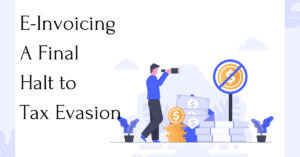The basics of e-Invoicing
- What is e-Invoicing?
Ans. e invoicing under gst or Electronic Invoice is the process of generation of Invoices in a specified format as per a schema, so it is readable by all other users. These Invoices are to be authenticated and reported on the Invoice registration Portal (IRP) where a unique QR Code & Invoice reference Number is given to the invoice.
- What is applicability of e-Invoicing?
Ans. No, Electronic Invoices are only mandatory for businesses with an aggregated turnover of over 100 Crores. There are certain Business classes exempted from e-Invoicing- Insurance & Banking Companies, financial institutes, non-banking financial institutes, GTA, Passenger Transportation Service.
- From when will e-Invoicing be implemented?
Ans. The e-Invoicing implementation date has been extended in the 39th GST Council meeting to be October 1st, 2020.
- Will my E-Way Bill be automatically generated because of e-Invoicing?
Ans. Part A of the E-Way Bill shall be auto populated through the information shared by the IRP of an E-Invoice. However, a taxpayer needs to fill the Part B (Vehicle detail) of the E-Way Bill on his own.
All about the Generation Process
- Do E-Invoices need to be generated from the IRP or GST Portal?
Ans. No, it is a misconception. The Invoices shall be generated from the ERP itself, by the taxpayer, in the same way as before. The taxpayer only needs to report these Invoices on the IRP for authentication.
- What are the mandatory Fields in e-Invoicing?
Ans. In an E-Invoice there are some Optional fields & some Mandatory fields, which are to be filled compulsorily or the Invoice shall be labelled invalid. These mandatory fields vary depending on the type of Supplier/supply/Invoice. However, generic, there are-
Total 18 Sections where- 10 are optional & 8 are mandatory. Within these 8 sections there are- 34 fields & 64 optional fields. In other words, minimum 33 fields are mandatory on an E-Invoice.
- For how long will the E-Invoice be available on IRP?
Ans. The E-Invoice shall be available for 24 hours after uploading, on the IRP.
- Is the IRP server sturdy enough to handle the volume of Invoices in case of uploading of high bulk amount of E-Invoices?
Ans. To avoid any technical glitches, the GSTN has provided 10 IRPs. These can easily handle high volumes of E-Invoices & Users at the same time.
- What should be done, if I have a bulk amount of E-Invoices to be uploaded to IRP?
Ans. The bulk generation facility is available on the IRP, so the user can upload N numbers of invoices at once.
The need for e-Invoicing
- What is the purpose behind e-Invoicing?
Ans. The basic purpose of the Government to imply Electronic Invoicing is to restrict tax leakage & fraud, by the real-time tracking and thorough authentication of the Invoice.
- What is the purpose of e-Invoicing form Business perspective?
Ans. The purpose of e-Invoicing from Business perspective is to make compliance simpler and Reconciliation more meticulous. The purpose is to bring a systematic approach to invoicing and GST return filings
- Are there any other documents to be reported on the Invoice Registration Portal?
Ans. Yes, apart from the B2B Invoices, B2G Invoices, Credit Notes, Debit Notes, Export Invoices & Reversed Charge Invoices must also be uploaded to the IRP.
All about IRP, IRN & QR Code
- In which format can we download E-Invoice from IRP?
Ans. The IRP shall generate the E-Invoice in either JSON or PDF format, as per the users’ convenience, although the same hasn’t been confirmed by the GSTN, information is subject to changes as per new notifications.
- What is an IRN in e-Invoicing?
Ans. IRN is a unique Invoice Reference Number which is allotted to each E-Invoice upon authentication through the IRP along with a unique QR Code.
- What are the parameters used in creating an IRN for an E-Invoice?
Ans. There are three parameters used to create the IRN,
- Suppliers’ GSTIN
- Suppliers’ Invoice number
- Financial Year in ‘YYYY-YY’ form
The parameter characters are then converted using the hash generation algorithm into numbers.
- Is it necessary to generate a QR Code?
Ans. QR Code is mandatory on all E-Invoices, especially for Businesses with a turnover of more than Rs 500 Cr, must generate QR Codes for their B2B as well as B2C Invoices.
- What is the role of QR Codes in Electronic Invoices?
Ans. The role of the QR Code is basically to give quick access to essential information of the E-Invoices. Scanning of the QR code using a scanner can give access to essential Invoice related information like Buyer/Seller GSTIN, Invoice number, HSN Codes, etc, in a machine-readable form
Acceptance, Rejection & Cancellation Of E-Invoice
- How will the user know if their E-Invoice has been accepted or approved?
Ans. On acceptance of the Invoice, the IRP generates the E-Invoice with IRN & QR Code, and the user can assume that the E-Invoice has been accepted.
- What is Rejection of E-Invoice? How can a user know, their invoice is rejected?
Ans. An Invoice is considered rejected if any of the mandatory fields are left unfilled/ are missing by the person who generated the Invoice. As soon as the user uploads the Invoice with error on the IRP, a dialogue box appears stating that the Invoice has been rejected. The errors are highlighted and the user needs to revise and re-upload it on the IRP.
- Can I make some changes once the E-Invoice is generated?
Ans. No, E-Invoice once generated cannot be modified or changed in any way, it has to be canceled and a new E-Invoice needs to be generated.
Significance of authentication of Invoices & its Effects

- Why is the validation of Electronic Invoices done?
Ans. The validation has significance both from the Business & Government perspective-
- For Businesses- The validation prevents errors, losses & frauds, making the business flow simpler & seamless.
- For Government- The validation gives a real-time track and hold over the smallest sales made, increasing transparency and hence helping control the evasion of Taxes.
- What effect does e-Invoicing have on Businesses & Government?
- The Businesses- are finding it highly helpful in compliance and reconciliation, although as a con the process is lengthy and increases the work
- The Government- is benefitted from the transparency of the process, since GST fraud is always a tending affair for the GSTN. e-Invoicing and validation of the Invoice is an effective way to keep a keen eye on it.
e-Invoicing- making Reconciliation thorough
- How is e-Invoicing helpful in Reconciliation?
Ans. e-Invoicing is highly helpful with reconciliation since it automates the generation of Annexure-1 & 2. The E-Invoices & it’s relevant data shall also be available for the GST Portal, E-Way Bill Portal as well as for the Tax officials, to access in case of need, this eliminates the need for manual reconciliation which consumes time & gives rise to manual reconciliation errors.
- How does e-Invoicing help in ITC claims?
Ans. e-Invoicing makes reconciliation simpler and more transparent which makes the ITC claim smooth and accurate.
e-Invoicing- Compliance made seamless
- How will e-Invoicing help Businesses in Compliance?
Ans. e-Invoicing will definitely help business comply better with GST & it’s rules. The manual processes are eliminated and reconciliation becomes better & thorough which makes the overall compliance with the system easier in terms of ITC claims, notices & penalties, etc.
- Can I link several Invoices in case of Credit or Debit Notes?
Ans. Yes the IRP provides the facility to link Invoices in case of Credit or Debit Notes.
- Will my GSTRs will be auto filed through e-Invoicing?
Ans. No, as per the upcoming new GST Returns, there are 2 part of GST-RET 1; Annexure-1 (Sales Report) & Annexure-2 (Purchase Report) which are required to file the Return. These to Annexure shall be auto-populated through the E-Invoices. These two Annexures can later be used to file the Returns by the user.
E-Invoice for Businesses
- What is the process to generate an E-Invoice?
Ans. The Invoice is to be generated from the ERP in the Schema format. This will then be uploaded on IRP in JSON. The IRP will validate the Invoice and assign an IRN & QR Code. The user can download the E-Invoice in the JSON format for further use, they can also convert the file in any other formats like PDF.
- Are there any other ways to generate E-Invoice?
Ans. There are other ways to generate e-Invoicing given by the Government, through the App, through SMS, and through APIs, however, SMS & App facilities are not yet confirmed to be used.
- How does API work?
Ans. API works on the principle of a site-to-site integration of systems. In E-Invoice, an API is used to link the users’ system to the IRP, so the generation, validation, and other operations on the E-Invoice could be done from within the ERP itself. This shortens the length of the process, eliminated double entries & errors.
One such API provider is GSTHero. GSTHero is a government authorized GST Suvidha Provider and reliable in terms of strength, security, Ease of operation & user-friendly software solutions.
Apart from the E-Invoicing Solution, GSTHero enables the user to generate their sales & purchase data from the ERP. This data can further be used to Auto-generate GSTRs from the GSTHero Portal, which only needs to be uploaded in the GST Portal. GSTHero high key Simplifies & makes the processes short to benefit your Business by saving time and man-power, with ease.
Given how essential the compliance is, GSTHero API Integration is a top notch solution for the e-Invoicing complications.
About the Author– – Prachi W- Is a researcher and writer from the field of core Finance, with a writing experience in the field of Business Market and Business Taxes. She has been into the Taxation field for more than 2 years and in the field of writing for over an year. She researches & analyses the latest trends in GST & Business Taxes to write detailed and perceptive articles about them.


